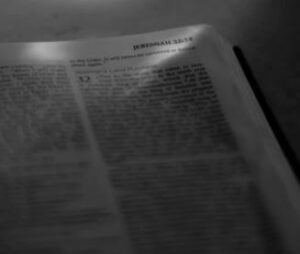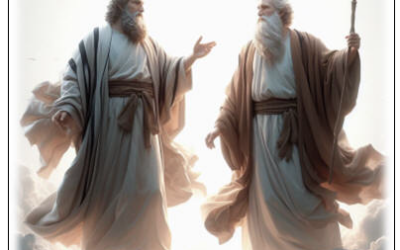 Critics of Christianity frequently accuse the New Testament of “misquoting” the Old Testament.1Perhaps the most challenging example of this is the citation which Matthew attributes to Jeremiah in Matthew 27:9-10. The words he quotes are not found in Jeremiah at all, but most closely resemble a citation of Zechariah 11:13 (though with notable differences). Even sincere Christian readers can sometimes find this passage confusing and wonder what Matthew was thinking. How can we reconcile this with a view that this gospel is the inspired, inerrant word of God?
Critics of Christianity frequently accuse the New Testament of “misquoting” the Old Testament.1Perhaps the most challenging example of this is the citation which Matthew attributes to Jeremiah in Matthew 27:9-10. The words he quotes are not found in Jeremiah at all, but most closely resemble a citation of Zechariah 11:13 (though with notable differences). Even sincere Christian readers can sometimes find this passage confusing and wonder what Matthew was thinking. How can we reconcile this with a view that this gospel is the inspired, inerrant word of God?
The verses in question
Let’s take a look at the passage in question:
“Then that which was spoken through Jeremiah the prophet was fulfilled: ‘And they took the thirty pieces of silver, the price of the one whose price had been set by the sons of Israel; and they gave them for the Potter’s Field, as the Lord directed me,” (Matthew 27:9-10).
The apparent problem is that these words are not found anywhere in Jeremiah’s writings. We do find a very similar passage In Zechariah:
“Then the Lord said to me, ‘Throw it to the potter, that magnificent price at which I was valued by them.’ So I took the thirty shekels of silver and threw them to the potter in the house of the Lord,” (Zechariah 11:13).
Critics will thus claim that Matthew was confused, ignorant, and even malicious and deceitful in conflating the words of Jeremiah with those of Zechariah and (as is often asserted), “altering” Zechariah’s words to better fit his point. A closer look, however, shows us that Matthew was doing nothing of the sort. Instead, he was intentionally drawing together themes from both authors to make a larger prophetic point.
An Old Testament example
Before we get into the details of Matthew 27:9-10, it is worth noting that Matthew is acting in an ancient, biblical tradition.
“Those who had escaped from the sword he carried away to Babylon; and they were servants to him and to his sons until the rule of the kingdom of Persia, to fulfill the word of the Lord by the mouth of Jeremiah, until the land had enjoyed its sabbaths. All the days of its desolation it kept sabbath until seventy years were complete,” (2 Chronicles 36:20-21)
The author of 2 Chronicles attributes all of this to Jeremiah without reference to any other book or author. Now, Jeremiah did prophesy several times that the Jews would remain in Babylon for seventy years (Jeremiah 25:11-12, 29:10), but the rest of this does not come from Jeremiah at all! Instead, it is actually alluding to Leviticus:
“You, however, I will scatter among the nations and will draw out a sword after you, as your land becomes desolate and your cities become waste. ‘Then the land will enjoy its sabbaths all the days of the desolation, while you are in your enemies’ land; then the land will rest and enjoy its sabbaths. All the days of its desolation it will observe the rest which it did not observe on your sabbaths, while you were living on it,” (Leviticus 26:33-35).
Thus, the author of 2 Chronicles provided a mixed quotation involving material primarily from Leviticus but one additional detail from Jeremiah. He then incorporated information from his own day to showcase the fulfillment and attributed the whole thing to Jeremiah. There is no reason to think that the author of 2 Chronicles was trying to trick the reader nor that he mixed up Leviticus and Jeremiah by accident. Instead, he seems to have assumed that his readers were familiar enough with the Law and the Prophets to follow his logic as he used the words of Leviticus and the contemporary events of the return from exile to more fully explain both the purpose and the fulfillment of Jeremiah’s seventy years.
So, understanding that this was a biblical, Jewish approach to citing Old Testament Scriptures, what was Matthew doing? Let’s take a closer look.
Jeremiah, Zechariah, and Matthew 27:9-10
Bearing in mind what we’ve seen from our Old Testament example, let’s look at Matthew’s citation again, side-by-side with the primary source in Zechariah. I have color-coded the parallel content to show connections:
“Then that which was spoken through Jeremiah the prophet was fulfilled: ‘And they took the thirty pieces of silver, the price of the one whose price had been set by the sons of Israel; and they gave them for the Potter’s Field, as the Lord directed me” (Matthew 27:9-10).
“Then the Lord said to me, ‘Throw it to the potter, that magnificent price at which I was valued by them.’ So I took the thirty shekels of silver and threw them to the potter in the house of the Lord,” (Zechariah 11:13).
Just as the author of 2 Chronicles paraphrased the content of Leviticus, Matthew has clearly done the same here, but the details from this passage in Zechariah are all there. Yet, this still leaves us with the question, why connect this with Jeremiah? Just as 2 Chronicles was drawing on Jeremiah’s “seventy years” passages, Matthew appears to be drawing on Jeremiah’s “potter” prophecies.
Jeremiah and the potter
Matthew’s reference connects the purchase of the potter’s field not only with Zechariah’s potter but also with a lengthy portion of Jeremiah. Jeremiah 18-19 provides an extended prophetic narrative involving a visit to a potter’s shop. It opens:
“The word which came to Jeremiah from the Lord saying, ‘Arise and go down to the potter’s house, and there I will announce My words to you.’ Then I went down to the potter’s house, and there he was, making something on the wheel. But the vessel that he was making of clay was spoiled in the hand of the potter; so he remade it into another vessel, as it pleased the potter to make,” (Jeremiah 18:1-4).
God uses this as an analogy. If God plans to judge and punish a nation, but that nation repents, He can instead remake them into a blessed nation (or vice versa). God then sends Jeremiah to appeal to Judah:
“So now then, speak to the men of Judah and against the inhabitants of Jerusalem saying, ‘Thus says the Lord, “Behold, I am fashioning calamity against you and devising a plan against you. Oh turn back, each of you from his evil way, and reform your ways and your deeds.”’ But they will say, ‘It’s hopeless! For we are going to follow our own plans, and each of us will act according to the stubbornness of his evil heart,’” (Jeremiah 18:11-12).
Jeremiah 18:18-23 goes on to describe the Jewish leaders’ plot against Jeremiah in words such as “Come and let us devise plans against Jeremiah. Surely the law is not going to be lost to the priest, nor counsel to the sage, nor the divine word to the prophet!” It is not hard to see the parallels between this and the plot Judas was involved in to betray Jesus. Jeremiah then returns to the potter:
“Thus says the Lord, ‘Go and buy a potter’s earthenware jar, and take some of the elders of the people and some of the senior priests. Then go out to the valley of Ben-hinnom, which is by the entrance of the potsherd gate, and proclaim there the words that I tell you, and say, “Hear the word of the Lord, O kings of Judah and inhabitants of Jerusalem: thus says the Lord of hosts, the God of Israel, ‘Behold I am about to bring a calamity upon this place, at which the ears of everyone that hears of it will tingle,'”‘” (Jeremiah 19:1-3).
The jar is later used to act this out:
“Then you are to break the jar in the sight of the men who accompany you and say to them, ‘Thus says the Lord of hosts, “Just so will I break this people and this city, even as one breaks a potter’s vessel, which cannot again be repaired; and they will bury in Topheth because there is no other place for burial. This is how I will treat this place and its inhabitants,” declares the Lord, “so as to make this city like Topheth,”‘” (Jeremiah 19:10-12).
Because they chose to continue in wickedness rather than repent, God was going to punish them, overthrow Jerusalem, and destroy the temple. This was true in Jeremiah’s day and was equally true in Jesus’. Matthew has already drawn attention to this, as when he reported Jesus’ words:
“Jerusalem, Jerusalem, who kills the prophets and stones those who are sent to her! How often I wanted to gather your children together, the way a hen gathers her chicks under her wings, and you were unwilling. Behold, your house is being left to you desolate!” (Matthew 23:37-38).
Matthew explains that the rejection and unjust killing of Jesus was the culmination of the rejection and persecution of all the prophets before, such as in the parable of the landowner and the vineyard (Matthew 21:33-46) or when Jesus says:
“so that upon you may fall the guilt of all the righteous blood shed on earth, from the blood of righteous Abel to the blood of Zechariah, the son of Berechiah, whom you murdered between the temple and the altar,” (Matthew 23:35).
Thus, the rejection and persecution of Jeremiah followed by the destruction of Jerusalem in Jeremiah’s day pictured in advance the future rejection of the Messiah and the subsequent destruction of Jerusalem in the first century AD. The parallels connect even on minor issues. The potter passage in Jeremiah pronounces judgment “…because they have filled this place with the blood of the innocent” (Jeremiah 19:4). In Matthew, Judas throws the money back into the temple because he had “sinned by betraying innocent blood.” (Matthew 27:4). Jeremiah tells us that a place “will no longer be called Topheth or the valley of Ben-hinnom, but rather the valley of Slaughter.” (Jeremiah 19:6). In Matthew, when the potter’s field is bought, we are told of a similar name change, “For this reason that field has been called the Field of Blood to this day,” (Matthew 27:8).
Much more could be said, but as can hopefully be seen through this brief demonstration, Matthew connected the events of Jesus’ rejection, betrayal, and death with a lengthy section of Jeremiah (too long to quote fully in its own right but doubtless quite familiar to his Jewish readers) by relating both to another prophecy in Zechariah. In this, he was following the tradition of the Old Testament writers themselves as we saw in 2 Chronicles.
But why does Matthew 27:9-10 mention a field?
One detail in Matthew’s citation that is not plainly taken from Zechariah or the potter prophecies in Jeremiah is the reference to a potter’s field. Why does Matthew 27:9-10 insert the idea of a field into the composite citation of these two prophets? There are two possible explanations.
The first and simplest is that Matthew is just explaining precisely how Zechariah’s words were fulfilled. Zechariah mentions that thirty pieces of silver are “thrown” to the potter, but he doesn’t explain why they are thrown (rather than simply handed) nor why to the potter. In connecting the words to Judas, we now see why the silver was thrown. Matthew also clarifies that the silver is given to the potter to purchase his field. Matthew’s citation is plainly not meant to be a word-for-word quotation, so he may just be explaining why the thirty pieces of silver go to the potter, i.e., to purchase a field.
However, it is also plausible that the reference to purchasing a field is also meant to connect this citation with a promise in Jeremiah. In chapter 32, Jeremiah (at God’s command) measures out shekels of silver to purchase and redeem a field. Interestingly, Jeremiah 32 connects the arrest and imprisonment of Jeremiah and the dark warnings of Jerusalem’s impending destruction with the promise of a future restoration. The purchase of the field is used as a reminder that one day God will bring His people home from exile. Thus, if Matthew intended the purchase of the field with the silver to bring this passage to mind as well, it actually draws in a message of hope! Though our hands are stained even with the innocent blood of the righteous, there is hope for forgiveness and restoration if we, unlike Judas or the hardened Jewish leaders, will repent and turn in faith.
Conclusion: Matthew 27:9-10 is not a misquotation
Ancient writers, including biblical writers, did not always cite sources in the straightforward manner we are accustomed to today. Matthew is no exception. Yet, when we take the time to understand what he is doing, we can see that there was no mistake here. Matthew was carefully, even brilliantly, drawing together the events of his times with rich and lengthy passages from the prophets which would have been too long to quote in full. His approach allowed him, in only a few words, to connect and show the ultimate fulfillment of numerous Old Testament passages in a way that would have made sense to his original (primarily Jewish) readers. There is certainly no error nor deception in Matthew 27:9-10.
References
| 1↑ | For other examples, see: Does Hebrews 8:9 misquote Jeremiah 31:32, Does Luke 4:18 misquote Isaiah 61:1, Does Hebrews 10:5 misquote Psalm 40:6, and Does Matthew 2:6 misquote Micah 5:2-4? |
|---|






